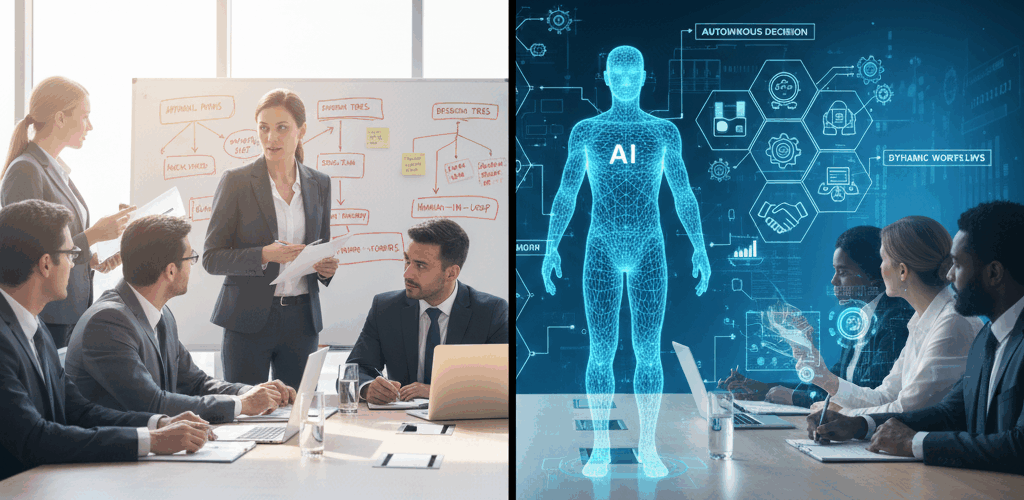EN
DE
NL
Most companies are making a mistake: they’re treating agentic AI as an IT project. They see it as a slightly fancier version of automation—a way to boost productivity or cut costs.
This thinking fundamentally misunderstands the challenge. Introducing AI that can make autonomous decisions is not a technical upgrade; it’s an organizational transformation that requires rethinking your company’s deepest structures.
1. Agentic Transformationis not a Technical Upgrade
When you deploy a true AI “agent,” you’re not just installing a tool; you’re introducing a new actor into your business processes.
This demands a complete redefinition of your operating model:
- Who approves what: You must establish human-in-the-loop structures that define the precise boundaries of AI autonomy and human oversight.
- AI Accountability: Responsibility is no longer solely human. You need new layers of accountability for decisions made by non-human systems.
- Team Collaboration: Teams must learn to collaborate with systems that act and execute rather than merely assist and analyze.
This is not an IT rollout; it’s an organizational redesign with legal, ethical, and operational consequences.
2. It’s a Mindset and Maturity Journey
Like digital transformation before it, the agentic shift is a maturity journey that must move through stages. You can’t leap straight to full autonomy.
The path generally follows these steps:
| Stage | Description | Key Focus |
| 1. Assisted Operations | AI supports human tasks. | Productivity & Augmentation |
| 2. Co-Directed Workflows | AI shares control and makes constrained, semi-autonomous decisions. | Shared Control & Guardrails |
| 3. Agentic Ecosystems | AI executes complex, multi-step operations with high-level human oversight. | Full Autonomy & Oversight |
| 4. Adaptive Governance | AI systems evolve within defined ethical and operational boundaries. | Trust & Ethical Integrity |
The Reality Check: Most companies are currently stuck between Stage 1 (experimenting) and Stage 2 (cautiously co-directing). The leap to structural autonomy is a major one that few are truly prepared for.
3. Time + Trust = Sustainability
You cannot rush the adoption of agentic structures. The true bottleneck isn’t the technology—it’s trust.
Building an agentic organization demands trust mechanisms, not just faster processors:
- Internal Auditing Loops: Mechanisms for reviewing and explaining autonomous decisions to ensure compliance and fairness.
- Clear Explainability Standards: Systems must be able to articulate why a decision was made.
- Cultural Acceptance: Fostering a culture where “AI is a colleague, not a threat” is crucial for adoption.
Trust takes time. Sustainable transformation is built on this foundation, not on rushing to hit an ROI metric.
4. The Human Center of Agentic Change
The biggest differentiator in successful agentic transformation will be a human-centered approach.
This shift should not start with dashboards and ROI slides, but with empathy, ethics, and experimentation.
Design Thinking and human-centered design principles must ground every implementation. The focus must be on how the AI changes the human experience—for the employee, the customer, and the organization as a whole—not just what it automates.
The takeaway: If you’re “adopting agentic AI,” you’re committing to an organizational redesign. Start by updating your org chart and accountability frameworks, not your tech stack.
Where is your company on this 4-stage journey? What’s the biggest structural bottleneck you’ve encountered?
Sources delivered by Perplexity:
https://www.perplexity.ai/search/i-just-had-a-conversation-abou-kwZRJIJGSNeNa72u248l9g?0=d&1=r#0
https://www.nbcnews.com/tech/innovation/coca-cola-causes-controversy-ai-made-ad-rcna180665
